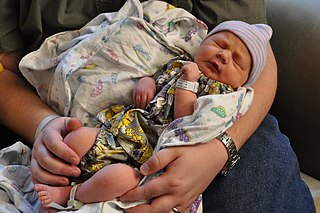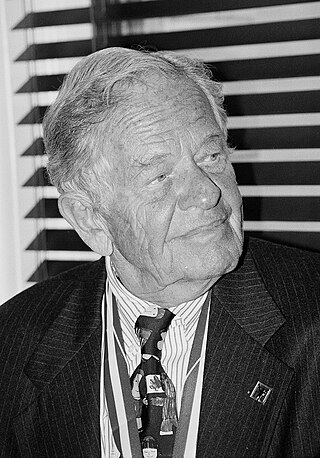
In common terminology, a baby is the very young offspring of human beings; while infant is a formal or specialised synonym. The terms may also be used to refer to juveniles of other organisms. A newborn is, in colloquial use, a baby who is only hours, days, or weeks old; while in medical contexts, a newborn or neonate is an infant in the first 28 days after birth.

Plagiocephaly, also known as flat head syndrome, is a condition characterized by an asymmetrical distortion of the skull. A mild and widespread form is characterized by a flat spot on the back or one side of the head caused by remaining in a supine position for prolonged periods.

Baby sign language is the use of manual signing allowing infants and toddlers to communicate emotions, desires, and objects prior to spoken language development. With guidance and encouragement, signing develops from a natural stage in infant development known as gesture. These gestures are taught in conjunction with speech to hearing children, and are not the same as a sign language. Some common benefits that have been found through the use of baby sign programs include an increased parent-child bond and communication, decreased frustration, and improved self-esteem for both the parent and child. Researchers have found that baby sign neither benefits nor harms the language development of infants. Promotional products and ease of information access have increased the attention that baby sign receives, making it pertinent that caregivers become educated before making the decision to use baby sign.

Thomas Berry Brazelton was an American pediatrician, author, and the developer of the Neonatal Behavioral Assessment Scale (NBAS). Brazelton hosted the cable television program What Every Baby Knows, and wrote a syndicated newspaper column. He wrote more than two hundred scholarly papers and twenty-four books.
Baby talk is a type of speech associated with an older person speaking to a child or infant. It is also called caretaker speech, infant-directed speech (IDS), child-directed speech (CDS), child-directed language (CDL), caregiver register, parentese, or motherese.

Attachment theory is a psychological and evolutionary framework concerning the relationships between humans, particularly the importance of early bonds between infants and their primary caregivers. Developed by psychiatrist and psychoanalyst John Bowlby (1907–90), the theory posits that infants need to form a close relationship with at least one primary caregiver to ensure their survival, and to develop healthy social and emotional functioning.
Cuteness is a type of attractiveness commonly associated with youth and appearance, as well as a scientific concept and analytical model in ethology, first introduced by Austrian ethologist Konrad Lorenz. Lorenz proposed the concept of baby schema (Kindchenschema), a set of facial and body features that make a creature appear "cute" and activate ("release") in others the motivation to care for it. Cuteness may be ascribed to people as well as things that are regarded as attractive or charming.

Encephalocele is a neural tube defect characterized by sac-like protrusions of the brain and the membranes that cover it through openings in the skull. These defects are caused by failure of the neural tube to close completely during fetal development. Encephaloceles cause a groove down the middle of the skull, or between the forehead and nose, or on the back side of the skull. The severity of encephalocele varies, depending on its location.
Mary Dinsmore Ainsworth was an American-Canadian developmental psychologist known for her work in the development of the attachment theory. She designed the strange situation procedure to observe early emotional attachment between a child and their primary caregiver.
Attachment measures, or attachment assessments, are the various procedures used to assess the attachment system in children and adults. These procedures can assess patterns of attachment and individual self-protective strategies. Some assessments work across the several models of attachment and some are model-specific. Many assessments allow children and adults' attachment strategies to be classified into three primary attachment pattern groups: B-pattern, A-pattern, C-pattern. In most models, each pattern group is further broken down into several sub-patterns. Some assessments are capable of finding additional information about an individual, such as unresolved trauma, depression, history of family triangulation, and lifespan changes in the attachment pattern. Some assessments specifically or additionally look for caregiving behaviors, as caregiving and attachment are widely considered two separate systems for organizing thoughts, feelings, and behavior. Some methods assess disorders of attachment or romantic attachment.

Stranger anxiety is a form of distress that children experience when exposed to strangers. Stranger anxiety and stranger fear are two interchangeable terms. Stranger anxiety is a typical part of the developmental sequence that most children experience. It can occur even if the child is with a caregiver or another person they trust. It peaks from six to 12 months but may recur afterwards until the age of 24 months. As a child gets older, stranger anxiety can be a problem as they begin to socialize. Children may become hesitant to play with unfamiliar children. Foster children are especially at risk, particularly if they experienced neglect early in their life.
In physical attractiveness studies, averageness describes the physical beauty that results from averaging the facial features of people of the same gender and approximately the same age. The majority of averageness studies have focused on photographic overlay studies of human faces, in which images are morphed together. The term "average" is used strictly to denote the technical definition of the mathematical mean. An averaged face is not unremarkable, but is, in fact, quite good looking. Nor is it typical in the sense of common or frequently occurring in the population, though it appears familiar, and is typical in the sense that it is a good example of a face that is representative of the category of faces.
Co-regulation is a term used in psychology. It is defined most broadly as a "continuous unfolding of individual action that is susceptible to being continuously modified by the continuously changing actions of the partner". An important aspect of this idea is that co-regulation cannot be reduced down to the behaviors or experiences of the individuals involved in the interaction. The interaction is a result of each participant repeatedly regulating the behavior of the other. It is a continuous and dynamic process, rather than the exchange of discrete information.
Cupboard love is a popular learning theory of the 1950s and 1960s based on the research of Sigmund Freud, Anna Freud, Melanie Klein and Mary Ainsworth. Rooted in psychoanalysis, the theory speculates that attachment develops in the early stages of infancy. This process involves the mother satisfying her infant's instinctual needs, exclusively. Cupboard love theorists conclude that during infancy, our primary drive is food which leads to a secondary drive for attachment.

The visual cliff is an apparatus created by psychologists Eleanor J. Gibson and Richard D. Walk at Cornell University to investigate depth perception in human and other animal species. It consists of a sturdy surface that is flat but has the appearance of a several-foot drop part-way across. The visual cliff apparatus allowed them to conduct an experiment in which the optical and tactile stimuli associated with a simulated cliff were adjusted while protecting the subjects from injury.

Attachment theory, originating in the work of John Bowlby, is a psychological, evolutionary and ethological theory that provides a descriptive and explanatory framework for understanding interpersonal relationships between human beings.
Developmental homeostasis is a process in which animals develop more or less normally, despite defective genes and deficient environments. It is an organism's ability to overcome certain circumstances in order to develop normally. This can be a circumstance that interferes with either a physical or mental trait. Many species have a specific norm, where those who fit that norm prosper while those who don't, don't survive or find it difficult to thrive. It is important that the animal be able to interact with the other group members effectively. Animals must learn their species' norms while they're young to live a normal, successful life for that species.

Maternal sensitivity is a mother's ability to perceive and infer the meaning behind her infant's behavioural signals, and to respond to them promptly and appropriately. Maternal sensitivity affects child development at all stages through life, from infancy, all the way to adulthood. In general, more sensitive mothers have healthier, more socially and cognitively developed children than those who are not as sensitive. Also, maternal sensitivity has been found to affect the person psychologically even as an adult. Adults who experienced high maternal sensitivity during their childhood were found to be more secure than those who experienced less sensitive mothers. Once the adult becomes a parent themselves, their own understanding of maternal sensitivity will affect their own children's development. Some research suggests that adult mothers display more maternal sensitivity than adolescent mothers who may in turn have children with a lower IQ and reading level than children of adult mothers.
Facial expressions are used to communicate emotions. They can also occur solitarily, without other people being present. People often imagine themselves in social situations when alone, resulting in solitary facial expressions. Toddlers and children in early childhood use social cues and contexts to discriminate and recognize facial expressions. They develop at this early stage facial expressions in order to provoke reactions from their caregivers and receive nurturance and support. Children reflect their peers' emotions in their own expressions for social interaction.
Social emotional development represents a specific domain of child development. It is a gradual, integrative process through which children acquire the capacity to understand, experience, express, and manage emotions and to develop meaningful relationships with others. As such, social emotional development encompasses a large range of skills and constructs, including, but not limited to: self-awareness, joint attention, play, theory of mind, self-esteem, emotion regulation, friendships, and identity development.










